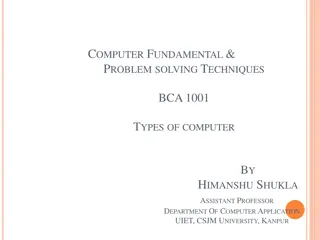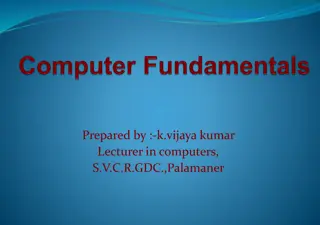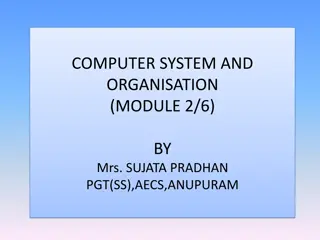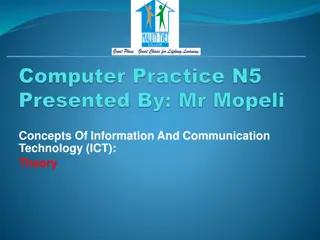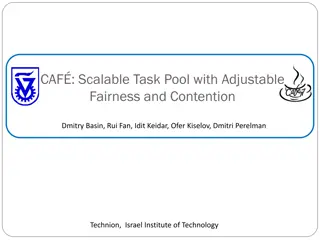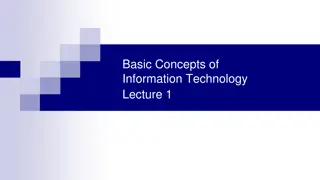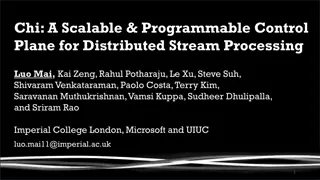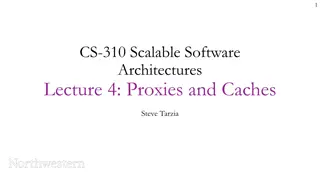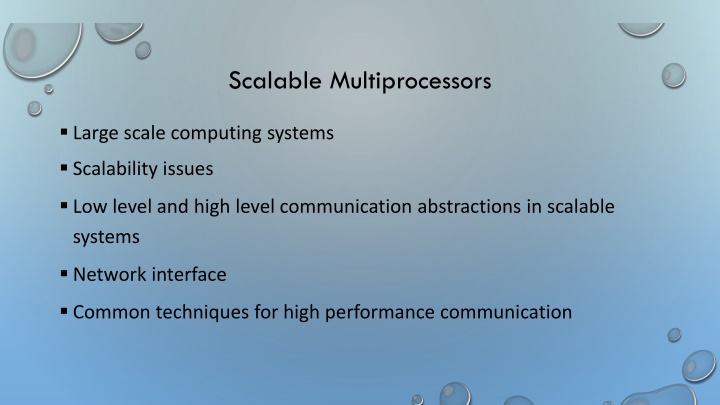
Scalable Computing Systems and Communication Abstractions
Explore the scalability issues and communication abstractions in large-scale computing systems, tackling topics like bandwidth scalability, latency scalability, and cost scaling in scalable machines.
Download Presentation

Please find below an Image/Link to download the presentation.
The content on the website is provided AS IS for your information and personal use only. It may not be sold, licensed, or shared on other websites without obtaining consent from the author. If you encounter any issues during the download, it is possible that the publisher has removed the file from their server.
You are allowed to download the files provided on this website for personal or commercial use, subject to the condition that they are used lawfully. All files are the property of their respective owners.
The content on the website is provided AS IS for your information and personal use only. It may not be sold, licensed, or shared on other websites without obtaining consent from the author.
E N D
Presentation Transcript
Scalable Multiprocessors Large scale computing systems Scalability issues Low level and high level communication abstractions in scalable systems Network interface Common techniques for high performance communication
Scalable computers Today s data centers are very large. What kinds of systems can scale to a large size? Almost all computers allow the capability of the systems to be increased oAdd memory, add disk, upgrade processor, etc. A scalable system attempt to avoid inherent design limits on the extent to which resources can be added to the system. oTotal communication bandwidth increases with P. oLatency (time per operation) remains a constant (not increase with P). oCost increases slowly (at most linearly) with P. oHow to package the (large/scalable) systems. Or, can we build a large systems with the design?
Example: Bus based SMP and Local Area Networks (LAN) Are they scalable? o Bus: Close coupling among components, but has a scaling limit. o Ethernet: no limit to physical scaling, little trust, no global order, independent failure and restart. Bandwidth does not scale.
Bandwidth scalability What fundamentally limits bandwidth? o The set of wires Processors and memory modules must have independent wires. Modules must be connected through switches (or scalable interconnects) that allows wires connected to the ports to be independent.
Latency scalability Latency = overhead + channel time + routing delay. Overhead: software/hardware processing time before the message is sent. Channel time: message size / channel bandwidth* # of channels. o # of channels usually increases as P increases. Routing delay: is usually a function of H (number of hops between two nodes) and P. o H usually increases as P increases. To make latency scalable: channel time and routing delay needs to be a constant.
Cost Scaling cost(p, m) = fixed cost + incremental cost (p, m) oScalable machines must support many configurations. oBoth fixed cost and incremental cost are important: Without volume, fixed cost can be very high.
Communication in scalable computers Components are far apart in a large scale computing system. The system must support communication among the components in a cost-effective manner. The communication subsystem (from software communication library to the hardware interconnection network) is a key component in a scalable computer. o Layers of abstractions
Communication abstractions High level and low level communication abstractions in scalable systems are often separated. oLayered design principle. oLow level: Provide accesses to communication hardware. Perform primitive network transactions. oHigh level: Provide functionality for communications in different programming models. Shared memory space abstraction Message passing abstraction
Network Transaction Primitive (low level) One-way transfer of information from a source output buffer to a destination input buffer. causes some action at the destination occurrence is not directly visible at source Deposit data, state change, reply
Shared address space abstraction No storage logically outside the application address space. Read and write remote memory (as well local memory, but this does not involve communication) Operations are fundamentally request/reply: read request/read reply with data; write request with data/write acknowledgement Source and destination data addresses are specified by the source of the request. o A degree of logical coupling and trust. Remote operation can be performed on remote memory oThis may or may not require intervention of the remote processor.
Shared Address Space Abstraction (high level) The following figure shows the read operation. Fundamentally a two way request/response protocol. o Write has an acknowledge.
Issues in Shared Address Space Abstraction Fixed or variable length (bulk) transfers. Remote virtual or physical address? Deadlock avoidance (circular dependence when input buffers are full)
Message passing abstraction For a programming paradigm where coordination and communication between processes are through explicit message passing (instead of shared memory), message passing abstraction is needed. Sender only knows about its memory and receiver only knows about its own memory. o Need a handshake for both of them to have all information about the communication. Synchronous message passing o Send completes after matching recv and source data sent o Recv completes after data transfer complete from matching send Asynchronous message passing o Send completes after send buffer may be reused.
Asynchronous Message Passing: Optimistic Wildcard receive non-deterministic Storage requirement within messaging layer.
Asynchronous Message Passing: Conservative Where is the buffer? Contention control? Receiver initiated protocol Short message optimizations
Summary of message passing abstraction Arbitrary storage outside the local address space May post many sends before any receives Non-blocking asynchronous sends reduces the requirement to an arbitrary number of descriptors There are limits to these too. Fundamentally a 3-phase transaction Includes a request/response Can use optimistic 1-phase in limited safe cases
Network interface Network interface (card) is used to access the network Transfer between local memory and NIC buffers. Basic operations SW translates VA PA SW initiate DMA SW does buffer management NIC initiates interrupts on receive Provides protection Transfer between NIC buffers and the network Generate packets Flow control with the network
Typical sender/receiver operations in a system with a low end NIC Sender: Trap into operating systems Translate (logical) destination address into physical address or the route to the destination Copy data into OS and construct the whole packet Select the outgoing channel, set the status registers (starting address, count, etc), and start the communication. Depending on NIC hardware, starting comm may take many instructions Receiver: An interrupt is generated The processor reads the received data into a OS region. CPU is still involved with a low end NIC. With a high-end NIC, the CPU operations can be offloaded to the communication processor in the NIC.
Protected User-level Communication Traditional NIC (e.g. Ethernet) requires the OS kernel to initiate DMA and to manage buffers. Protection High overhead: kernel/user space switching in communication critical path. Newer NICs (InfiniBand, Myrinet) OS initializes the network ports to provide protection. Applications access the ports from the user domain. Kernel/user space switching is no longer needed in send/recv.
User-level communication Any user process can post a transaction for any other in protection domain Communication layer moves the source OQ to the desitnation IQ May involve indirection: the source virtual memory to destination virtual memory (RDMA).



